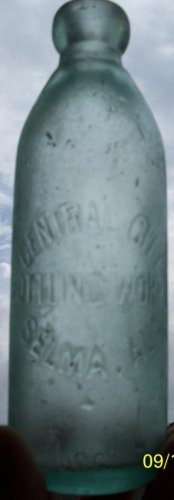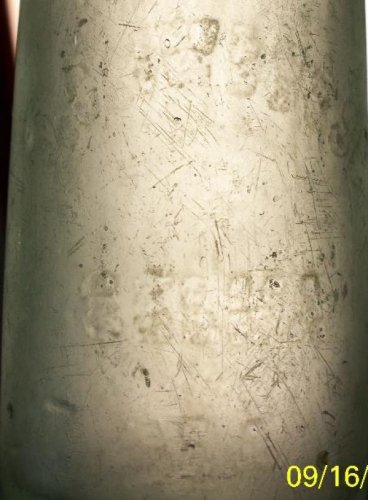You are using an out of date browser. It may not display this or other websites correctly.
You should upgrade or use an alternative browser.
You should upgrade or use an alternative browser.
double embossing?
- Thread starter bama1
- Start date
This is the back of the bottle. Was this common? The embossing is VERY light and can only make out some of what it says. ?.CorG. IWEPSSE SELMA, ALA. ^ (maybe)^. Anyway, was this ground down, or was this on one side of the mold that was filled in in order to reuse it, or is there another reason?


Attachments
FloridaRecycled
Well-Known Member
I know that with fruit jars they would re-work the molds...mainly when one company bought out another and they changed the molds...this actually helps to date it more closely...is that your best guess as to what WAS on it?
I can't really tell. I tried all sorts of combinations and didn't get a hit. Regardless, someone has a unusual last name? Would tumbling be a good idea for this bottle or would it just wipe out the remaining embossing?
cc6pack
Well-Known Member
bama
try using a piece of paper and pencil and do a rubbing. I would not tumble it if you are worried about the back side. just soak it.
try using a piece of paper and pencil and do a rubbing. I would not tumble it if you are worried about the back side. just soak it.
RED Matthews
Well-Known Member
Hi bama1, I think that the bottle mold set was let together by removing metal from one face of the mold halves. This is not easy to conclude, because we do no know what type of mold face lock-up was used. Earliest know methods known were the use of dowel pins in one half that matched with a hole in the other half. Some times there were two dowels set on one side and sometimes there was one set on each side. I have even seen where they used three dowels; one set high and one set low on the same side with one set in the center height of the other side.
Then they went to a dovetail type of lock up with a 20º angle lengthwise on the mold parting face and an opposite 20º on the other side. This made a wide flat between them and the mold cavity was in the center of that.
From there they went to a narrow tongue and groove on one side of the cavity. I would have loved going to the Clevenger's auction to see all the different lock-ups. I have seen many at Wheaton Museum and around the world. I need to get to the Fenton Glass Museum to make an assessment of this feature on their many old molds that have been collected by them.
Some unwanted lettering was removed by peening. I think the lettering in yours was just blended out by a mold maker. The problem there, being that it affects the capacity of the bottle, buy probably not enough to hurt the product loss. I did think it odd that your two pictures seemed so different from each other in color and comparison.
I hope this helps a little. If you have more questions, feel free to send them to me.
RED M.
Then they went to a dovetail type of lock up with a 20º angle lengthwise on the mold parting face and an opposite 20º on the other side. This made a wide flat between them and the mold cavity was in the center of that.
From there they went to a narrow tongue and groove on one side of the cavity. I would have loved going to the Clevenger's auction to see all the different lock-ups. I have seen many at Wheaton Museum and around the world. I need to get to the Fenton Glass Museum to make an assessment of this feature on their many old molds that have been collected by them.
Some unwanted lettering was removed by peening. I think the lettering in yours was just blended out by a mold maker. The problem there, being that it affects the capacity of the bottle, buy probably not enough to hurt the product loss. I did think it odd that your two pictures seemed so different from each other in color and comparison.
I hope this helps a little. If you have more questions, feel free to send them to me.
RED M.
Similar threads
- Replies
- 6
- Views
- 932
- Replies
- 3
- Views
- 1K
- Replies
- 2
- Views
- 324
- Replies
- 12
- Views
- 2K
Latest posts
-
-
-
-
I have an old soda bottle with a rounded bottom
- Latest: Abn@9352920
-
Latest threads
-
-
I have an old soda bottle with a rounded bottom
- Started by Abn@9352920
- Replies: 0
-
-
-
Interesting bottle and contents find at George Washington's Mount Vernon Estate!
- Started by willong
- Replies: 0
-
Once in a lifetime? Moral of the story never overlook fallen tree stumps
- Started by Bluestreak39
- Replies: 2



